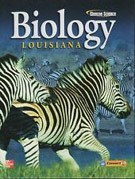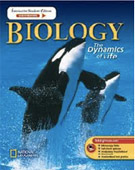Biology is a branch of the natural sciences, and is the study of living organisms and how they interact with their environment. Biology deals with every aspect of life in a living organism. Biology examines the structure, function, growth, origin, evolution, and distribution of living things. It classifies and describes organisms, their functions, how species come into existence, and the interactions they have with each other and with the natural environment. Four unifying principles form the foundation of modern biology: cell theory, evolution, genetics and homeostasis ( See full Wiki article). This year we will teach Biology by the newly revised Next Generation Science Standards.
The Next Generation Science Standards aim to eliminate the practice of "teaching to the test." Instead, they shift the focus from merely memorizing scientific facts to actually doing science—so students spend more time posing questions and discovering the answers for themselves.(http://ngss.nsta.org/why-standards-matter.aspx)
Table of contents in sequence:
Science and Engineering Practices describe what scientists do to investigate the natural world and what engineers do to design and build systems. The practices better explain and extend what is meant by "inquiry" in science and the range of cognitive, social, and physical practices that it requires. Students engage in practices to build, deepen, and apply their knowledge of core ideas and crosscutting concepts.
1. Asking questions (for science) and defining problems (for engineering)
2. Developing and using models
3. Planning and carrying out investigations
4. Analyzing and interpreting data
5. Using mathematics and computational thinking
6. Constructing explanations (for science) and designing solutions (for engineering)
7. Engaging in argument from evidence
8. Obtaining, evaluating, and communicating information
Disciplinary Core Ideas (DCIs) are the key ideas in science that have broad importance within or across multiple science or engineering disciplines. These core ideas build on each other as students progress through grade levels and are grouped into the following four domains: Physical Science, Life Science, Earth and Space Science, and Engineering.
HS-LS1 - From Molecules to Organisms: Structures and Processes
HS-LS1-1
Construct an explanation based on evidence for how the structure of DNA determines the structure of proteins which carry out the essential functions of life through systems of specialized cells.
HS-LS1-2
Develop and use a model to illustrate the hierarchical organization of interacting systems that provide specific functions within multicellular organisms.
HS-LS1-3
Plan and conduct an investigation to provide evidence that feedback mechanisms maintain homeostasis.
HS-LS1-4
Use a model to illustrate the role of cellular division (mitosis) and differentiation in producing and maintaining complex organisms.
HS-LS1-5
Use a model to illustrate how photosynthesis transforms light energy into stored chemical energy.
HS-LS1-6
Construct and revise an explanation based on evidence for how carbon, hydrogen, and oxygen from sugar molecules may combine with other elements to form amino acids and/or other large carbon-based molecules.
HS-LS1-7
Use a model to illustrate that cellular respiration is a chemical process whereby the bonds of food molecules and oxygen molecules are broken and the bonds in new compounds are formed resulting in a net transfer of energy.
HS-LS2 - Ecosystems: Interactions, Energy, and Dynamics
HS-LS2-1
Use mathematical and/or computational representations to support explanations of factors that affect carrying capacity of ecosystems at different scales.
HS-LS2-2
Use mathematical representations to support and revise explanations based on evidence about factors affecting biodiversity and populations in ecosystems of different scales.
HS-LS2-3
Construct and revise an explanation based on evidence for the cycling of matter and flow of energy in aerobic and anaerobic conditions.
HS-LS2-4
Use a mathematical representation to support claims for the cycling of matter and flow of energy among organisms in an ecosystem.
HS-LS2-5
Develop a model to illustrate the role of photosynthesis and cellular respiration in the cycling of carbon among the biosphere, atmosphere, hydrosphere, and geosphere.
HS-LS2-6
Evaluate the claims, evidence, and reasoning that the complex interactions in ecosystems maintain relatively consistent numbers and types of organisms in stable conditions, but changing conditions may result in a new ecosystem.
HS-LS2-7
Design, evaluate, and refine a solution for reducing the impacts of human activities on the environment and biodiversity.
HS-LS2-8
Evaluate the evidence for the role of group behavior on individual and species' chances to survive and reproduce.
HS-LS3 - Heredity: Inheritance and Variation of Traits
HS-LS3-1
Ask questions to clarify relationships about the role of DNA and chromosomes in coding the instructions for characteristic traits passed from parents to offspring.
HS-LS3-2
Make and defend a claim based on evidence that inheritable genetic variations may result from: (1) new genetic combinations through meiosis, (2) viable errors occurring during replication, and/or (3) mutations caused by environmental factors.
HS-LS3-3
Apply concepts of statistics and probability to explain the variation and distribution of expressed traits in a population.
HS-LS4 - Biological Evolution: Unity and Diversity
HS-LS4-1
Communicate scientific information that common ancestry and biological evolution are supported by multiple lines of empirical evidence.
HS-LS4-2
Construct an explanation based on evidence that the process of evolution primarily results from four factors: (1) the potential for a species to increase in number, (2) the heritable genetic variation of individuals in a species due to mutation and sexual reproduction, (3) competition for limited resources, and (4) the proliferation of those organisms that are better able to survive and reproduce in the environment.
HS-LS4-3
Apply concepts of statistics and probability to support explanations that organisms with an advantageous heritable trait tend to increase in proportion to organisms lacking this trait.
HS-LS4-4
Construct an explanation based on evidence for how natural selection leads to adaptation of populations.
HS-LS4-5
Evaluate the evidence supporting claims that changes in environmental conditions may result in: (1) increases in the number of individuals of some species, (2) the emergence of new species over time, and (3) the extinction of other species.
HS-LS4-6
Create or revise a simulation to test a solution to mitigate adverse impacts of human activity on biodiversity.
Crosscutting Concepts help students explore connections across the four domains of science, including Physical Science, Life Science, Earth and Space Science, and Engineering Design and are taught throughout the course. When these concepts, such as "cause and effect", are made explicit for students, they can help students develop a coherent and scientifically-based view of the world around them. They are:
1. Patterns
2. Cause and Effect: Mechanism and Explanation
3. Scale, Proportion, and Quantity
4. Systems and System Models
5. Energy and Matter: Flows, Cycles, and Conservation
6. Structure and Function
7. Stability and Change
Click here to go to Day 1>


